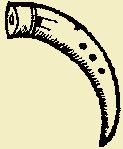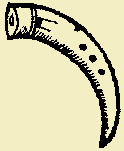The gemshorn is a wind instrument that is made out of the chamois, or goat’s horn. Its name basically means ‘chamois horn’ in German. Initially, the gemshorn was used during the medieval era. The evidence for its use is sparse and scattered, mainly from the late middle age, renaissance, and baroque period. Although its history is not well-known, the oldest reference of the gemshorn was in the Musica Getutscht, an illustration of a German composer named Sebastian Virdung. According to Virdung, the gemshorn has about four finger holes. Another reference of this instrument appears beneath the foundation of a house that dated back from 1455. In this reference, the gemshorn has four finger holes, the same as Virdung’s description.
Aside from that, a skeletal figure of the gemshorn was also featured in Danse Macabre (Dance of Death), illustrated in 1485. Following that, in 1488, a German book called Heidelberger Totentanz has also featured an instrument that looks very much like a gemshorn. In the illustration, it was also clear that it seems like a haunting horn and has a narrow end. However, in this illustration, the gemshorn lacks fingerholes as it was held or played by a figure of death. Other instruments that were seen were bray harp, Tromba marina, bagpipes, psaltery, and lute.
The 16th-century version of this instrument has recorded to have about seven fingerholes. In 1529, the German renaissance musician named Martin Agricola had published his Musica instrumentalis Deudsch. This includes illustrations, as well as information for this instrument that seems to be taken from Virdung’s work. Usually, the 15th century and the 16th-century version have a chromatic range of one octave. By the end of the 16th century, the gemshorn was mostly used as a pastoral instrument and had later on fallen out of use. Overall, the gemshorn appears rarely in any known iconography and documents. Also, it only appears in Germany, and there were no musical compositions that are written explicitly for the gemshorn.

The sound of the gemshorn is like the sound of the flute, although it has an ocarina-like sound that lacks harmonic overtones. In addition, there is what they called the gemshorn organ stop. An organ stop is a part of a pipe organ that admits the pressurized air to the organ pipes. The gemshorn organ pipes are conical in shape and have a wide end where the wind is going in.
Unlike the traditional gemshorn, the modern gemshorn is now made out of domesticated cattle horns since they were readily available. As well as that, this is to prevent the endangering of the wild species. This instrument has tone holes down its front, much like the clarinet and a recorder wind instrument. The pointed end of the horn remains and serves as the bottom part of the instrument. Meanwhile, on the wide end of the gemshorn, a fipple or mouthpiece made of wood is usually attached for tone production.
Additionally, on more advanced versions of the gemshorn, there is a metal band or ring. This metal band called the tuning ring is placed in between the top tone hole and the voicing window. Through this ring and the horn beneath, a hole is then drilled. When this ring is turned, the hole is partially blocked. The function of this ring is to lower the gemshorn’s keynote by about one major note. Other musicians prefer to use alternatives, like synthetic materials, in making the gemshorn. Some use woods instead of using a real animal’s horn.

